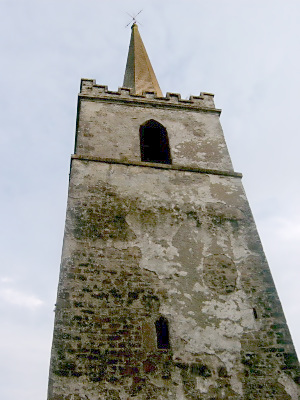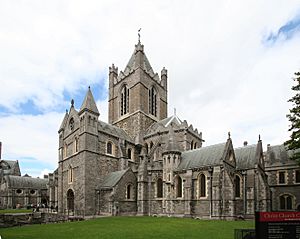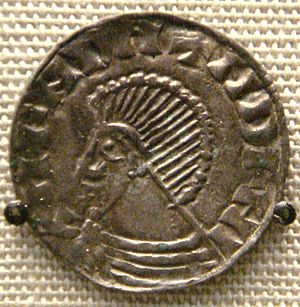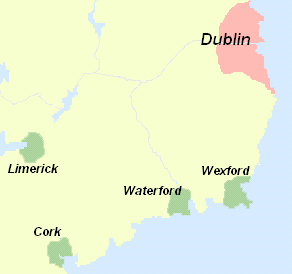Sigtrygg Silkbeard facts for kids
Quick facts for kids Sigtrygg Silkbeard |
|
|---|---|
| King of Dublin | |
| Reign | 989/995–1036 |
| Predecessor | Glúniairn / Ivar of Waterford |
| Successor | Echmarcach mac Ragnaill |
| Born | c. 970 Dublin |
| Died | 1042 (aged 72) Dublin |
| Spouse | Sláine |
| Dynasty | Uí Ímair |
| Father | Olaf Cuarán |
| Mother | Gormflaith ingen Murchada |
Sigtrygg II Silkbeard Olafsson was a powerful Viking king of Dublin. He ruled for a long time, from about 989 to 1036. His family, the Uí Ímair dynasty, was very important in Ireland.
Sigtrygg was involved in many big events in Irish history. He had to deal with the famous Irish king, Brian Boru. His family even made marriage alliances with Boru's family. Later, Sigtrygg became a main leader in the big Battle of Clontarf in 1014.
His reign lasted 46 years. During this time, his armies fought in many parts of Ireland. He also led raids into places like Meath, Wicklow, and Ulster. Sometimes, his forces even raided the coast of Wales. He also fought against other Viking kings in places like Cork and Waterford.
In 1028, Sigtrygg went on a special trip to Rome. He is also known for helping to start Christ Church Cathedral in Dublin. Even though Dublin faced some tough times during his rule, trade in the city generally did very well. Sigtrygg died in 1042.
Contents
Life of a Viking King
Family Background
Sigtrygg had both Viking and Irish family roots. His father was Olaf Cuarán. Olaf was a king of both York in England and Dublin in Ireland. Sigtrygg's mother was Gormflaith ingen Murchada.
Gormflaith was the daughter of Murchad mac Finn, the King of Leinster. Her brother, Máel Mórda, also became King of Leinster. Gormflaith had been married before to Máel Sechnaill, who was a King of Meath and a High King of Ireland.
Sigtrygg also had an older half-brother named Glúniairn, which means "Iron-knee." Glúniairn was King of Dublin before Sigtrygg, from 980 to 989.
Becoming King of Dublin
Sigtrygg likely became King of Dublin in 989. However, another Viking leader, Ivar of Waterford, might have also ruled Dublin around that time. The old Irish records don't say much about Sigtrygg's first few years as king.
One idea is that Olaf Tryggvason, who later became King of Norway, lived in Dublin for a while. He married Sigtrygg's sister, Gytha. Having a strong Viking leader like Tryggvason in Dublin might have kept Irish raids away.
When Tryggvason left Dublin in 994, Sigtrygg was temporarily forced out of the city. His rival, Ivar of Waterford, took over. But Sigtrygg returned within a year. In 995, he and his nephew attacked a church in County Meath. In response, Máel Sechnaill, the Irish king, entered Dublin. He took important Viking treasures like the ring of Thor and the sword of Carlus.
Sigtrygg then attacked other towns like Kells and Clonard in 997. By 998, Máel Sechnaill and Brian Boru, the King of Munster, made Sigtrygg agree to their rule. Sigtrygg had to give them hostages, which was a sign of his submission.
Sigtrygg knew that Dublin's wealth made it a target. He needed strong friends and good city walls. The land around Dublin didn't have enough resources to fight powerful Irish princes. So, Sigtrygg first made an alliance with his uncle, Máel Mórda mac Murchada, the King of Leinster. In 999, they defeated another Leinster king and put him in prison in Dublin.
First Revolt Against Brian Boru
Later in 999, the people of Leinster, who didn't like being controlled by powerful Irish kings, joined forces with the Vikings of Dublin. They rebelled against Brian Boru. This was Sigtrygg's second alliance with his uncle, Máel Mórda.
Brian Boru's army crushed the combined Leinster-Dublin forces at the Battle of Glenmama. After this victory, Brian attacked Dublin itself. He stayed in Dublin for several weeks, plundered the city, and burned the Viking fortress. He also forced Sigtrygg to leave.
Sigtrygg tried to find help from other Irish tribes, but they refused. Since he couldn't find safety in Ireland, he eventually returned to Dublin. He submitted to Brian Boru, gave him hostages, and was allowed to be king again after three months. During this time, Sigtrygg might have become a pirate for a short period, raiding places like St David's in Wales.
To make peace stronger, Brian Boru's daughter married Sigtrygg. In return, Brian married Sigtrygg's mother, Gormflaith.
Years of Peace and Raids

Dublin then had a peaceful time. Sigtrygg's soldiers fought in Brian Boru's armies. Sigtrygg remembered that the Ulaid tribe had refused to help him when he fled Dublin. So, in 1002, his soldiers helped Brian attack the Ulaid lands. Sigtrygg's fleet raided Ulster, taking many prisoners.
His forces continued to fight alongside Brian Boru in other campaigns. By 1011, Brian was recognized as the High King of all Ireland.
During these years, a Viking poem called the Sigtryggsdrápa was written about Sigtrygg. It praised him and described Dublin as a busy, rich port. Old items found by archaeologists, like ships, gold, and games, seem to show that Dublin was indeed a thriving city.
Second Revolt and the Battle of Clontarf
Around 1010, Brian Boru divorced Queen Gormflaith. She then started to encourage people to oppose Brian. By 1012, the relationship between Brian and Leinster was very bad, and a new rebellion began. Sigtrygg joined forces with Máel Mórda, the leader of this revolt. They defeated Brian's ally, Máel Sechnaill.
Sigtrygg sent his son Oleif with a fleet to attack Cork in Munster. This attack hurt Brian's naval power.
According to an old story, Njál's saga, Gormflaith strongly encouraged Sigtrygg to kill Brian. She sent him to get help from powerful Viking leaders like Earl Sigurd of Orkney and Bróðir and Óspak of Man. Sigtrygg promised them that if they won, they could marry Gormflaith and become King of Ireland.
The two armies met at the famous Battle of Clontarf on Good Friday in 1014. Many important leaders died in this battle, including Brian Boru and his son. Máel Mórda, Sigurd, and Bróðir also died.
Irish stories say that Sigtrygg did not fight in the battle himself. He stayed safe inside Dublin's walls. From there, he watched the battle unfold. This was a smart move, as he survived the battle. However, some older Viking stories say that Sigtrygg did fight bravely at Clontarf.
After Clontarf
After the Battle of Clontarf, Sigtrygg's power seemed to decrease, even though he kept his kingdom. Máel Sechnaill became the High King again. In 1015, a plague hit Dublin. Máel Sechnaill took this chance to burn Dublin's suburbs.
In 1018, Sigtrygg raided Kells. He took many valuable items and prisoners. These prisoners were either ransomed or sold as slaves, which was a big business in Dublin. In 1021, Sigtrygg's forces were defeated in County Wicklow. In 1022, his fleet was destroyed in a naval battle against Niall mac Eochaid.
After Máel Sechnaill died in 1022, things got even harder for Sigtrygg. Many Irish princes fought to become the High King. Dublin, with its wealth, became a target for anyone who wanted to rule Ireland.

Sigtrygg had to give hostages to powerful Irish kings in 1025 and 1026. This was to show his loyalty. But it didn't keep Dublin safe. In 1026, Dublin was raided again. Sigtrygg then made a new alliance. In 1027, his son Olaf joined a raid in Meath. Sigtrygg's army was defeated, and some leaders were killed.
In 1029, Sigtrygg's son Olaf was captured. Sigtrygg had to pay a huge ransom to get him back. This included 1,200 cows, 140 British horses, and much gold and silver. This shows how important it was to ransom noble prisoners. It was a way to gain power and weaken enemies.
Sigtrygg's luck improved in the 1030s. In 1030, he joined forces with Cnut the Great, a powerful Viking emperor. Their fleets raided Wales together. A Dublin settlement was even started in Wales. For a few years, Sigtrygg was very powerful.
In 1032, Sigtrygg won a big victory by himself, which was rare for his family. In 1035, he attacked the stone church of Ardbraccan in Meath. He burned 200 men inside and took another 200 as prisoners. In revenge, another Irish king plundered and burned a church near Dublin.
In the same year, Sigtrygg executed Ragnall, the King of Waterford. Ragnall was related to Ivar, Sigtrygg's old rival. In 1036, Echmarcach mac Ragnaill, the King of the Isles, forced Sigtrygg to give up his throne. Sigtrygg died in 1042, away from Dublin.
Family and Lasting Impact

Sigtrygg married Brian Boru's daughter, Sláine. They had one son named Olaf. Olaf died in 1034 while on a trip to Rome. Olaf had a daughter named Ragnhild. Her son, Gruffudd ap Cynan, became a king in Wales.
Sigtrygg had five other children from different relationships: Artalach (died 999), Oleif (died 1013), Godfrey (died 1036), Glúniairn (died 1031), and Cellach (died 1042). His son Oleif was killed in revenge for the burning of Cork. His son Glúniairn was killed in 1031. Godfrey was killed in Wales in 1036. Sigtrygg's daughter Cellach died in the same month as her father.
Sigtrygg was also known for supporting arts and helping the church. In the 990s, he started Ireland's first mint in Dublin, where coins were made. He also helped set up a bishopric in Dublin. In 1028, he went on a pilgrimage to Rome.
He is linked to the founding of Christ Church Cathedral, Dublin in Dublin. Today, this is the oldest building in Dublin. It was first a wooden building, then rebuilt in stone later. Like many coastal cathedrals in Ireland, it has Viking-Irish origins.
See also



